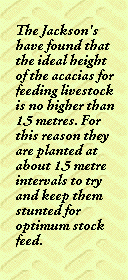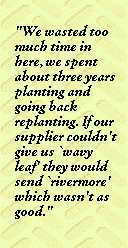
Bob and Carol Jackson have lived on their farm, which is about 43 kilometres north west of Mount Barker for the past 30 years. The farm is in the upper Kent River catchment and water from the farm flows into Lake Nunijup to the southeast before reaching the Kent River. Prior to clearing the area was covered with yate (Eucalyptus occidentalis) and wandoo (Eucalyptus wandoo) woodland with paperbark forest on the floodplain. The 770 hectare farm was first cleared about 50 years ago. At that time it was parkland cleared rather than chained and there are still a lot of remnant trees left on the property.
Bob and Carol have always farmed sheep and they only do a small amount of cropping for sheep feed. Over the last five years they have transformed what was 60 hectares of bare saline floodplain into productive grazing land using saltbush and other shrubs.
The Problem
The floodplain area was never cleared or fenced and sheep used to graze on the good clover feed. Bob and Carol noticed that the trees were dying about 15 years ago and they put this down to waterlogging and increasing salinity. Most of the trees eventually died and the floodplain became an area of bare salt scald that was useless for grazing.
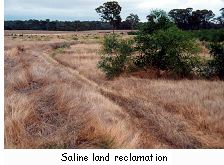 The Solution
The Solution
In about 1990 Bob dug a series of drains across the floodplain to move the water through faster. These drains were partially successful in addressing the waterlogging problem. During winter however, the water that flowed through the large main drain through the centre sometimes backed up. Bob has since enlarged a crossing downstream and has made it wider to take a greater flow. The Water and Rivers Commission also installed drains further downstream in 1999. Bob says that this action has had a positive effect on the waterlogging problem on the farm. There is still a problem with two small culverts on a shire road that don't take a high volume of water and Bob is hoping this will be addressed soon. "There's about a metre fall in about five kilometres so you can't afford to have too many hook ups". The original drains have been in place for about ten years and they have recently been upgraded. The main drains are now ready to be cleaned out with a grader.
Smaller drains have also been constructed in other waterlogged, saline areas of the property. These areas have been fenced and planted with saltbush and Acacia saligna.
The Jacksons fenced off some of the floodplain in 1993 and it was suggested to them that they plant saltbush for stock feed. Bob removed all the dead trees using a bulldozer and they began hand planting in 1995 with plants purchased from a nursery. At that time it cost 25 cents per plant to get them to the farm so they decided to start growing their own 'wavy-leaf' and 'old man' saltbush. This has been successful and they are now in their third year of planting their home grown plants. They also tried to grow Acacia saligna and although it grew well, they found that it was too difficult to transplant because of the deep root system. They now buy the acacias as seedlings.
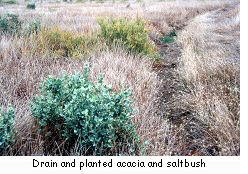 Bob and Carol originally grew the saltbush in pots but found that it was too tedious and that they dried out too quickly. Now the seeds are planted directly into a plot approximately ten metres by three metres, which holds about 15 000 plants and is close to the house. As the plants grow they are trimmed back to a height of about 30 centimetres using a whipper snipper as often as required. They have found that this keeps the plant stems thick and strong. When the plants are ready to be transplanted, 200-400 are dug up with a fork and taken straight to the site. After sowing the seeds in about November they are ready to hand-plant out in June or July the following year. The Jacksons believe that they would lose fewer plants through waterlogging if they were planted out in August or September when the soil is drier but this does not fit in with their other farm activities. They have found that they average a 70% survival rate depending on the soil type and amount of waterlogging. Bob and Carol both agree that the time factor is the biggest consideration when carrying out this type of work.
Bob and Carol originally grew the saltbush in pots but found that it was too tedious and that they dried out too quickly. Now the seeds are planted directly into a plot approximately ten metres by three metres, which holds about 15 000 plants and is close to the house. As the plants grow they are trimmed back to a height of about 30 centimetres using a whipper snipper as often as required. They have found that this keeps the plant stems thick and strong. When the plants are ready to be transplanted, 200-400 are dug up with a fork and taken straight to the site. After sowing the seeds in about November they are ready to hand-plant out in June or July the following year. The Jacksons believe that they would lose fewer plants through waterlogging if they were planted out in August or September when the soil is drier but this does not fit in with their other farm activities. They have found that they average a 70% survival rate depending on the soil type and amount of waterlogging. Bob and Carol both agree that the time factor is the biggest consideration when carrying out this type of work.
Prior to planting the Jacksons decided not to do any weed control or to apply fertiliser. The area is ripped then mounded and the rows are put in at a rate of three to four per 20 metres. Bob says that they should really construct 2.5 rows per 20 metres so machinery can be moved along the rows. The Jacksons have found that the ideal height of the acacias for feeding livestock is no higher than 1.5 metres. For this reason they are planted at about 1.5 metre intervals to try and keep them stunted for optimum stock feed.
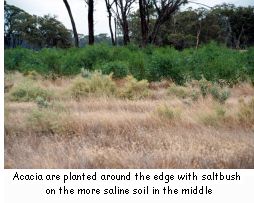 A combination of various types of saltbush and Acacia saligna is planted with the acacias around the edge on the less saline soils. The plants are allowed to grow for about 18 months to two years before sheep are introduced. Grazing is carefully controlled and the sheep are left in the area for six weeks to three months to allow for light grazing depending on the growth of the shrubs. If it gets too wet then they are also taken out. "I'm only going to lightly feed it, if you've got 300-400 sheep and let them stay there until it is bare, you cant afford to do that, those sort of practices are out". In some areas the sheep could be introduced earlier than 18 months but Bob prefers to save it for his ewes later on. Carol believes that the saltbush does better with grazing as even though the sheep strip the stems bare as far up as they can reach it will always regrow in a healthier state.
A combination of various types of saltbush and Acacia saligna is planted with the acacias around the edge on the less saline soils. The plants are allowed to grow for about 18 months to two years before sheep are introduced. Grazing is carefully controlled and the sheep are left in the area for six weeks to three months to allow for light grazing depending on the growth of the shrubs. If it gets too wet then they are also taken out. "I'm only going to lightly feed it, if you've got 300-400 sheep and let them stay there until it is bare, you cant afford to do that, those sort of practices are out". In some areas the sheep could be introduced earlier than 18 months but Bob prefers to save it for his ewes later on. Carol believes that the saltbush does better with grazing as even though the sheep strip the stems bare as far up as they can reach it will always regrow in a healthier state.
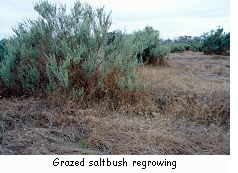 Some 'creeper' saltbush was planted in a couple of areas and the Jacksons noticed that the ants were spreading the seeds. All they need to do now is put two or three plants in each row and they spread with the help of the ants. It can also be transplanted by pulling up some root material and replanting it elsewhere.
Some 'creeper' saltbush was planted in a couple of areas and the Jacksons noticed that the ants were spreading the seeds. All they need to do now is put two or three plants in each row and they spread with the help of the ants. It can also be transplanted by pulling up some root material and replanting it elsewhere.
They have found that puccinellia will grow in some areas of the floodplain where the saltbush won't. This helps to stabilise the soil and also uses up some water. The 'rivermore' saltbush has not been highly successful and the Jacksons have not been able to grow it from seed. They have found that although it is higher in protein than the other types of saltbush it doesn't tolerate much stock grazing.
The Jacksons have noticed that the sheep will eat the saltbush first then they will feed on the acacias. For this reason they recommend that, if possible, the saltbush and the acacias should be planted in separate areas but then this increases the cost of fencing.
Grasses such as rye and wheat grass and clover are now recolonising what were the bare salt scald areas of the floodplain. In addition the Jacksons have noticed that within about 18 months of fencing there is a natural regeneration of yates and paperbarks. Some paperbarks were planted as part of their 1999 program and these appear to be growing well in the more saline areas.
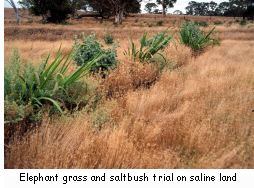 An elephant grass trial was started at the beginning of October 1999. About 200 cuttings were planted and the ones in the ripped and mounded areas are growing well. The Jacksons are going to continue planting more elephant grass as a trial to see how well it tolerates sheep grazing.
An elephant grass trial was started at the beginning of October 1999. About 200 cuttings were planted and the ones in the ripped and mounded areas are growing well. The Jacksons are going to continue planting more elephant grass as a trial to see how well it tolerates sheep grazing.
A stand of pure acacia was planted on a salty swamp in 1996. This has since been used for grazing but the sheep haven't been able to keep the shrubs low enough and they have kept growing. The Jacksons do not see this as a problem, however, as the shrubs are still utilising the water. In some areas the acacia is now regenerating naturally from seed.
Kangaroos have been a problem and Bob has seen up to 60 kangaroos on 20 hectares of replanting. "They don't seem to eat the saltbush but they eat the wheat grass and rye grass and acacias, or pull them out of the ground". Emus are also a problem but more on the pasture than the replanted areas. Rabbits have not been a problem in the replanted areas.
The Outcomes and Observations
Bob and Carol are pleased with their replanting work but admit that they wasted a lot of time at the beginning. "We wasted too much time in here, we spent about three years planting and going back replanting. If our supplier couldn't give us 'wavy leaf' they would send 'rivermore' which wasn't as good". This was when they decided to grow their own.
When asked what they would do differently Bob and Carol said they would have wider row spaces to enable a machine to get in and do more planting. They believe new varieties may become available and would like to have the ability to incorporate them easily into their plantings. They would not plant trees or shrubs on the major drain mound as it makes it too difficult to get a grader in to clean them out. If they had the choice they would also plant the acacia separate to the saltbush. Bob believes also that it is very important to carry out drainage before planting.
Bob can foresee a time when pasture takes a smaller role as stock feed and shrubs are utilised. He sees the shrubs being topped regularly by machine in a rotation and the stock eating the cuttings. "As more people grow these sort of things you will get farmers [working together]. Say the machine costs $20,000 you'll get four or five farmers that go in together and they'll buy that machine, and that way they can do their own work, or otherwise contractors might come up with it and do it".
The Jacksons have found their methods to be cost effective, "cost wise its probably cheap the way we're doing it; the fencing is not cheap, but the planting is".
Kent River Floodplain Statistics
| Type of stream: | Ephemeral creek and floodplain | |
| Average rainfall: | 500 mm./year | |
| Water quality: | saline | |
| Catchment disturbances: | Stock grazing, cropping |
